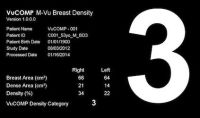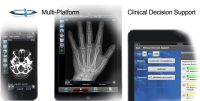Volpara Solutions has launched VolparaAnalytics and VolparaDose, two new quantitative breast imaging software tools built on the Volpara algorithm, which enables the generation of volumetric measurements, including density, patient specific dose, and applied pressure. Volpara is showcasing the expanded suite of breast imaging software tools for the first time at the European Congress of Radiology.
VolparaDensity is used by radiologists to objectively assess density from both digital mammography and tomosynthesis images and help evaluate who might benefit from additional screening. Highly correlated to breast MR assessments, VolparaDensity is a reliable tool, which automatically generates an objective measurement of volumetric breast density and a BI-RADS breast density category.
"My nurses and colleagues find VolparaDensity easy to use with minimal training. We use it to objectively determine high density before performing breast ultrasound screening. In tandem, my colleagues in gynaecology are finding it interesting to use the volumetric measurements to follow hormonal and anti-hormonal therapy,” said Professor André Grivegnée, Jules Bordet Institute, Brussels, Belgium.
VolparaAnalytics assists in quality assurance by monitoring and recording critical elements of the breast imaging process, including mammography, tomosynthesis and technologist performance. The software generates key imaging performance metrics to help understand the performance of technologists, readers and mammography machines and displays the information on a dashboard.
For each image received, VolparaAnalytics automatically extracts information about the x-ray physics parameters used, records mammography and technologist identifiers, and computes various novel metrics from that data, including volumetric breast density and pressure. Real-time alerts and reports can demonstrate, for example, whether one technologist is compressing too much, or if one mammography unit is operating differently to the others. This comparative information can help determine whether additional training or re-calibration is required.
“With VolparaAnalytics, breast screening programmes can now evaluate individual and regional differences in screening performance in the context of volumetric breast density. In research being presented this week at ECR, researchers from the DENSE trial will showcase results that suggest a geographical variation in mammographic density distribution is present in the Netherlands, which would support structural assessment of breast density within the screening programme,” said Ralph Highnam, CEO of Volpara Solutions.
VolparaDose moves away from manufacturer-specific radiation dose estimates to using a standard mean glandular dose algorithm along with the patient-specific volumetric breast density to give a better estimate of the dose absorbed by the specific breast. The dose can be inserted directly into patient letters on compatible mammography reporting systems, and sent to enterprise wide dose tracking systems. Currently, mammography systems generate a Mean Glandular Dose (MGD) based on an assumption of a homogeneous mixture of fat and fibroglandular tissue in standard proportions.
“We all know it’s critical to keep radiation dose as low as possible whilst retaining high image quality, and yet the current dose estimates in mammography may significantly under or over-estimate the actual patient dose because they generate calculations based on assumption of a homogeneous mixture of fat and fibroglandular tissue in standard, non-personalised proportions. We are presenting research this week which demonstrates that it is possible to improve the personalisation of radiation dose estimation, which may, in turn, allow for better optimisation of radiation dose in breast screening, both in mammography and tomosynthesis,” added Dr. Highnam.
Latest Articles
Mammography, Quality, Breast density
Volpara Solutions has launched VolparaAnalytics and VolparaDose, two new quantitative breast imaging software tools built on the Volpara algorithm, which e...



























